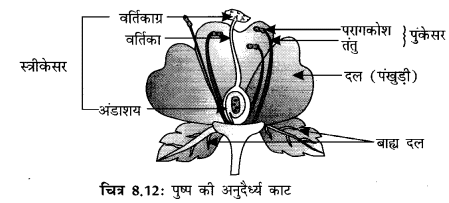Solved NCERT Questions For Class 10 Science Chapter 8 In Hindi - Free PDF
NCERT Solutions For Class 10 Science Chapter 8 How Do Organisms Reproduce? in Hindi - 2025-26
FAQs on NCERT Solutions For Class 10 Science Chapter 8 How Do Organisms Reproduce? in Hindi - 2025-26
1. What is the correct stepwise method to solve NCERT questions from Class 10 Science Chapter 8 as per CBSE guidelines?
To solve NCERT questions from Chapter 8, follow this stepwise method:
- Read the question carefully to identify the reproduction type or biological term involved.
- Recall relevant textbook concepts and definitions.
- Break the answer into logical steps (such as defining, comparing, or explaining processes).
- Support explanations with scientific terms like DNA replication, gamete formation, or cell division.
- Include labelled diagrams where required, as per CBSE pattern.
- Ensure the answer is concise, accurate, and follows the textbook approach.
2. How do NCERT Solutions for Class 10 Science Chapter 8 help develop conceptual clarity in 'How Do Organisms Reproduce'?
NCERT Solutions provide structured, step-by-step answers as per the CBSE pattern. They guide students through key stages such as identifying modes of reproduction, comparing asexual and sexual reproduction, and understanding the significance of genetic variation. Each solution addresses common textbook queries, highlights important steps, and clarifies processes via labelled diagrams, ensuring a thorough conceptual grasp.
3. What are some common mistakes students make while answering questions on sexual and asexual reproduction, and how can NCERT Solutions help avoid them?
Common mistakes include confusing the processes of sexual and asexual reproduction, omitting essential steps in cell division, failing to mention the role of DNA, or missing diagrams. NCERT Solutions provide model answers with each step clearly outlined, ensuring that all critical aspects are addressed and reducing the likelihood of errors.
4. Why is it important to use diagrams in NCERT Solutions for Science Chapter 8, and what should students focus on when drawing them?
Diagrams are essential because they visually explain structures such as the human reproductive system, flower parts, or reproductive cycles. When drawing diagrams in answers:
- Ensure correct labelling of all parts.
- Keep illustrations neat and to the point.
- Use diagrams to support the explanation, not just decorative purposes.
5. According to NCERT Solutions, what are the main differences between reproduction in unicellular and multicellular organisms?
In unicellular organisms, reproduction typically occurs by asexual methods such as binary fission or budding, resulting in offspring identical to the parent. Multicellular organisms mainly reproduce sexually, involving the formation of gametes (egg and sperm), fertilisation, and genetic mixing, leading to variation among offspring.
6. How do NCERT Solutions ensure answers for Chapter 8 align with the latest CBSE Science syllabus for 2025–26?
NCERT Solutions for Chapter 8 are formulated strictly as per the CBSE Science syllabus 2025–26. They cover all textbook exercises, address updated content, and follow the latest CBSE answer structuring and marking schemes, ensuring students practice only what is required for the upcoming academic year.
7. What should students keep in mind while writing step-by-step answers in accordance with NCERT Solutions for maximum marks in exams?
Students should:
- Clearly state definitions and key points in the first step.
- Organise each part of the answer sequentially as per the process, experiment, or diagram involved.
- Use scientific vocabulary provided in the NCERT textbook.
- Mention advantages or significance when relevant (e.g., genetic variation in sexual reproduction).
- Conclude by summarising the key point of the answer, as shown in the model NCERT Solutions.
8. What is the value of practising exercise-wise NCERT Solutions for Chapter 8 in exam preparation?
Practising exercise-wise NCERT Solutions enhances understanding of all question types, familiarises students with the CBSE answer format, and builds confidence in tackling both short and long-form questions. It ensures thorough revision of concepts and maximises exam readiness.
9. How can students apply the step-by-step methods from NCERT Solutions to new or higher-order questions in exams?
By mastering the step-by-step methods from NCERT Solutions, students can tackle new or unfamiliar questions by logically breaking them down, recalling related textbook concepts, and presenting structured explanations. This skill is critical for answering application-based or HOTS questions confidently.
10. What is the significance of following the NCERT Solutions pattern in gaining marks for long-answer questions in CBSE Class 10 Science exams?
Adhering to the NCERT Solutions pattern ensures that all parts of a long-answer question—such as definitions, explanations, diagrams, comparisons, and examples—are included, which is crucial for full marks in CBSE exams. This method helps in structuring responses as per the official CBSE marking guidelines.




















 Watch Video
Watch Video





















